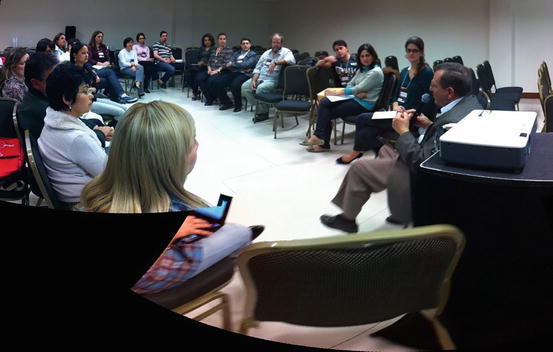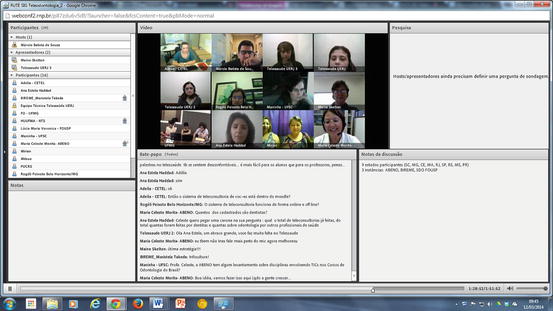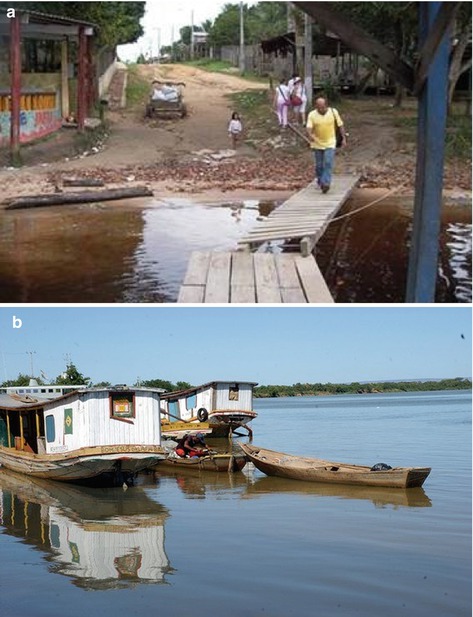Fig. 9.1
Brazil and its numbers
It is worthy to note that Brazil has adopted eHealth as a national policy applied to healthcare and education since 2006. It started as part of Ministry of Health national policy for development and capacity building of human resources for health. Many strategies have been developed and adopted aiming to reorient health professionals competencies to the healthcare model established in its universal access health system, based on primary health care. The strategies deal with undergraduate students, technical level health workers, residency and postgraduate programs. The educational policy implemented is based on three main guidelines: integration between universities and health services, a wider concept of health-disease process, based on the social determinants of health and new pedagogical approach based on active methodologies, including the use of information and communication technologies (ICT) [1, 2].
Brazil assumed health as a right of each citizen and for that its Federal Constitution created in 1988 the Unified Health System (SUS), which applies currently to more than 190 million inhabitants. One of the greatest challenges faced by universal health systems is how deal with the overpowering increase of new technologies applied to healthcare and, at the same time, guarantee universal access of population to high quality of care with sustainability. Human health resources play a central hole in this equation [3].
A special issue number of the Lancet with a series of papers about the Unified Health System (SUS) from Brazil was published in 2011. As far as the Millenium Development Goals – MDG are concerned, the editors highlight SUS achievements as the reduction of 50 % in low birth weight and two thirds decrease in infant mortality in the last decade [4, 5].
In this context, where we have SUS and more recently a national policy for human health resources, is that Brazilian eHealth strategies emerged and have been developed [4, 6–12].
The multiple strategies for eHealth include mainly the Brazilian Telehealth Program (www.telessaudebrasil.org.br) [13], Open University of the Unified National Health System – UNA SUS (www.unasus.gov.br) [14] and Telemedicine University Network – RUTE (www.rute.rnp.br) [15]. The activities grew faster between physicians and nurses. It has also a great acceptance and demand by Health Community Workers.
Dentistry has gained strength within SUS in 2000, when the dentists starting to integrate Family Health Teams at the primary health care level, and also with the creation of the Centers of Dental Specialties in 2005. By 2012 we reached approximately 18.000 out of 32.000 Family Health Teams that included dentists and 800 Centers of Dental Specialties all over the country. Until that most of the population had difficulties to dental treatment access. Epidemiological studies comparing the situation in 2000 and 2010 showed considerable improvement in dental health indicators, although we still have a great cumulative demand accumulated along many years before, especially in relation to adult oral health needs.
This active inclusion of Dentistry within SUS created the necessity for undergraduate programs to prepare better students to a new professional activity pattern, facing the challenge of working in a multiprofessional team, at public services and not only in private offices. Many programs and strategies are being promoted by the federal Government, specially by the Ministries of Health, of Education and of Science, Technology and Innovation to face the new challenges involving all health professionals, including dentists.
One of them is the eHealth strategy and to better integrate Dentistry [16, 17], it was created the National Teledentistry Network – RNTO (http://programa.telessaudebrasil.org.br/vhl/teleodontologia-em-foco/rede-nacional-de-teleodontologia-e-nucleos) in 2011 (Fig. 9.2). Its goal is to share and exchange successful experiences of telehealth applied to teledentistry, nationally and abroad. Two relevant RNTO initiatives must be mentioned. One of them is the e-learning course destined to institutions interested in developing Teledentistry Centers. It is divided in three modules: (1) How to implement and manage a Teledentistry Center; (2) How to train and stimulate professors to use more widely information and communication technologies (ICT) in the teaching-learning process; (3) How to support a service of teleconsultancies and Formative Second Opinion for health professionals. Each module has been structured by experienced professors and dentists already engaged on Brazilian Telehealth Program [13] and UNA SUS [14], establishing guidelines and learned lessons that may help new partners to better perform in the network. After defining the content and validating it by an experienced external committee, the module is developed with the support of a instructional design that has a pedagogical background. It is expected that this course may serve as a reference for teachers, health professionals, faculties of Dentistry and health services willing to start using ICT for teaching and learning and healthcare support.


Fig. 9.2
Launch of the National Network of Teledentistry with eight colleges/states represented, 2011 – Santa Catarina, Brazil
The second initiative, as part of RUTE [15], is the creation of a Special Interest Group (SIG) in Teledentistry (Fig. 9.3). It represents one, out of more than 40 SIGs already at work, in different specialties most of them in Medicine and Nursery. The Teledentistry SIG is a virtual space in which education and research institutions from all over the country get together virtually through video and web conference, discuss, share their experience and learn how to better work as an effectively connected network. This huge movement of education and research in health network was made possible by a cooperative initiative run by the Ministry of Science and Technology, with partnership with the Ministries of Education and of Health. A backbone of wide band has been built connecting all the public university hospitals and other relevant health services, connecting this national wide network dedicated to education and research in health field. There is a Social Organization, the National Network of Education and Research (www.rnp.br) [18], from the Ministry of Science and Technology, which is responsible for the development and management of RUTE.


Fig. 9.3
Teledentistry Special Interest Group – monthly meeting, at RUTE – Telemedicine University Network
The RNTO is run by the Brazilian Association of Dental Education (www.abeno.org.br) [19] and by the Teledentistry Center of the Faculty of Dentistry of University of Sao Paulo (www.teleodonto.fo.usp.br) [20], in partnership with the Telehealth Centers of the University of the State of Rio de Janeiro – UERJ (http://www.telessaude.uerj.br) [21], Federal University of Rio Grande do Sul – UFRGS (http://www.ufrgs.br/telessauders) [22] and the State Secretary of Health of Mato Grosso do Sul (http://telessaude.saude.ms.gov.br) [23]. The project is supported by the Ministry of Health (www.saude.gov.br) [24] with the cooperation of Pan American Health Organization (PAHO) [25]. The two initiatives are articulated and their effects on the function, strengthen and extension of the RNTO. It has also contributed for the improvement of healthcare, research and education in undergraduate and pos graduate dentistry courses all over the country.
The tools of Telehealth and Teledentistry allow break through the limits of the geographical and temporal distance, so that professionals, whether working in remote areas, have access to communication with other centers and services, no longer feel isolated (Fig. 9.4).


Fig. 9.4
(a) Geographic problems to access people – State of Minas Gerais. (b) Geographic problems to access people – State of Amazonas
Nowadays, whatever the diagnosis or health problem presented, there is a tendency of the population, with growing access to the Internet, to search for knowledge about their own condition. We must seize this window of opportunity to guide the search for quality information and credibility. It is important that professionals are prepared to take these guidelines as well as to be a source of reliable information about health promotion and prevention in relation to general health and oral health.
The first decade of the twenty-first century can be considered the starting point of the first Brazilian initiative in Teledentistry. Many distance-learning courses were produced in Brazil. It began with the concern of informing patients and professionals, for instance, about oral cancer [26].
The Department of FMUSP’s Telemedicine [27], which had already worked with telemedicine connections across Brazil, developed modules related to Dental Health. In the São Paulo Center that is linked to Brazils National Telehealth Program [13], a platform is used supporting continuous education for professionals working in primary health care. One of the projects being developed is the Virtual Human involving human anatomical and physiological aspects in 3D animation, with various titles related to dentistry, for instance: Temporomandibular Joint (TMJ), Dental Structure (2004); Anaesthesia in Paediatric Dentistry and tooth extraction of deciduous teeth (2011); Development of dental caries; and traumatic lesions (2007–2009) ATM and Dysfunctions (2008); Oral Health in the Elderly (2008).
These results led the USP team to participate in the planning and implementation of the Brazil Telehealth Network [13] program in 2006, in conjunction with the Brazilian Ministry of Health.
In Telecare, through collaboration with USP and USC, the development of Dental Telepropaedeutics was initiated, with the creation of online clinical records and educational lectures about drug interaction, the International Classification of Diseases (ICD), references, educational reports, epidemiologic data, and other [27]
The first and second Brazilian Meetings of Teledentistry were organized within the Congress of Brazilian Council for Telemedicine and Telehealth (CBTms) [28], resulting in a consensus document: Consensus Belo Horizonte [29], Minas Gerais – Brazil:
The dissemination of Teledentistry in Brazil is important to improve the quality of education, for this reason, the creation of Teledentistry centres of Higher Education Institutions (HEIs) should be encouraged along with the training of new professionals. The educational institutions, regulation and standard of Dentistry will ensure the appropriate use of technology in teaching, research and additional development.Dentistry has an important role in the health of the Brazilian population. With the help of Teledentistry, institutions and university groups can promote national stimulus programs for oral health, and the possibility of partnerships between public, private and non-governmental organizations (NGOs) and agencies.The modernization of educational iconography, through the development of learning tools should be considered as a strategic action to improve the quality of education in dentistry. It is important to join the Dental Front Pro-FUST (Fund for Universalization of Telecommunications Services) through the Department of Teledentistry of CBTMs and dental education articles. This section of dentistry is design for the release of funds from the FUST to be used in education and health.It is necessary to prepare the regulation for the use of Teledentistry among professionals and professional-patient relationship.The promotion of Brazilian Teledentistry at the 10th International Telemedicine Congress, which was held in October 2005 in São Paulo, was appropriate.Collaborating Teledentistry centres should be encouraged amongst HEIs for the sharing of projects and experiences in teaching, research and extensions.
The 25th International Dental Congress in 2007 discussed the ethics of Teledentistry and Distance Education. The debate allowed participants to clarify questions about the use of ICT (Information and Communication), with the emphasis on professional – patient relationship, the teaching and learning process, and the teacher-student relationship.
Stay updated, free dental videos. Join our Telegram channel

VIDEdental - Online dental courses


